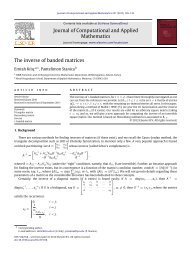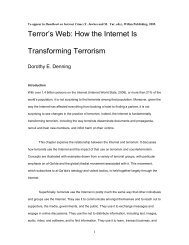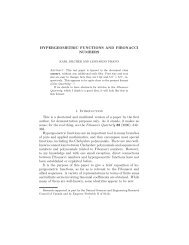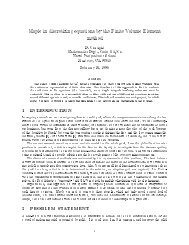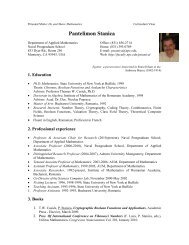Design of an Autonomous Amphibious Robot for Surf - index - Naval ...
Design of an Autonomous Amphibious Robot for Surf - index - Naval ...
Design of an Autonomous Amphibious Robot for Surf - index - Naval ...
Create successful ePaper yourself
Turn your PDF publications into a flip-book with our unique Google optimized e-Paper software.
Fig. 10. Whegs TM IV concept rendering<br />
to be encased <strong>an</strong>d sealed. There also has to be a way to<br />
actuate the body joint. Both <strong>of</strong> these goals are accomplished<br />
by extending the case <strong>of</strong> the front body segment around<br />
the whole chain <strong>an</strong>d sprocket that connects the two body<br />
segments. This protrusion <strong>of</strong> the case then mounts to the rear<br />
body segment at the middle axle in a coaxial arr<strong>an</strong>gement.<br />
The outer axle actuates the body joint <strong>an</strong>d the inner axle<br />
attaches to the sprocket <strong>an</strong>d chain to deliver torque to the<br />
front wheel-legs. By keeping all connections axial in nature,<br />
a st<strong>an</strong>dard rotary seal c<strong>an</strong> be used to keep water <strong>an</strong>d dust<br />
out.<br />
Rotary axles must also penetrate the body <strong>of</strong> the robot<br />
in six other places, one <strong>for</strong> each wheel-leg. Several rotary<br />
shaft seals are in consideration <strong>for</strong> this task. One possibility<br />
is a mech<strong>an</strong>ical seal, with two mating parts rotating against<br />
each other, one mounted to the shaft <strong>an</strong>d the other mounted<br />
to the body. Another possibility is a single or double Oring<br />
seal, which c<strong>an</strong> be specialized <strong>for</strong> positive <strong>an</strong>d negative<br />
pressure, but are more susceptible to leaking as grease wears<br />
<strong>of</strong>f. Finally, a spring loaded graphite ring c<strong>an</strong> mate with a<br />
polished shaft. All <strong>of</strong> these solutions may be complimented<br />
by pressurizing the hull to push air out, instead <strong>of</strong> pulling<br />
water in, if a leak occurs. Steering push rods that also<br />
penetrate the body <strong>of</strong> the robot <strong>an</strong>d must be sealed. Since<br />
they have a limited r<strong>an</strong>ge <strong>of</strong> motion, a flexible rubber bellows<br />
c<strong>an</strong> be perm<strong>an</strong>ently affixed to the push rod <strong>an</strong>d housing.<br />
Because the robot is intended to be autonomous with little<br />
or no knowledge <strong>of</strong> small obstacles in its immediate path, it<br />
is best if these obstacles c<strong>an</strong> be surmounted passively whenever<br />
possible. The a<strong>for</strong>ementioned strategies implemented in<br />
Whegs TM II are useful to this end. Whegs TM IV has several<br />
adv<strong>an</strong>cements to this end.<br />
A body joint on previous Whegs TM allowed the robot to<br />
climb larger objects by giving the front wheel-legs higher<br />
reach <strong>an</strong>d by preventing high centering. However, several<br />
designs have not survived field testing. The first version<br />
<strong>of</strong> Whegs TM ł with a body joint used a large backdrivable<br />
servo, which allowed the motor to absorb some <strong>of</strong> the<br />
shock <strong>of</strong> impact, but const<strong>an</strong>t current draw quickly drained<br />
the batteries. To remedy this, Whegs TM III used a nonbackdrivable<br />
worm gear. However, the teeth <strong>of</strong> the gear<br />
1469<br />
Fig. 11. Whegs TM IIII body joint drive shaft (right) <strong>an</strong>d middle axle (left)<br />
in coaxial arr<strong>an</strong>gement<br />
sheared <strong>of</strong>f under impact loading. The Whegs TM IV body<br />
joint has a worm gear in series with the tr<strong>an</strong>smission <strong>an</strong>d<br />
motor, like Whegs TM III. However, the tooth face is twice<br />
as large <strong>an</strong>d has been designed to withst<strong>an</strong>d the frequent<br />
impact loads the robot experiences, Fig. 11.<br />
The Interior view <strong>of</strong> component layout is seen in Fig 12.<br />
Whegs TM IV will include space <strong>for</strong> the components used<br />
by the NPS first generation autonomous vehicle. With the<br />
exception <strong>of</strong> the motor <strong>an</strong>d torsion devices, the front compartment<br />
is left free <strong>for</strong> electronics <strong>an</strong>d sensors. Batteries,<br />
speed controllers, the body joint mech<strong>an</strong>ism <strong>an</strong>d motor, <strong>an</strong>d<br />
additional electronics are stored in the rear body segment.<br />
With a microprocessor, GPS, compass <strong>an</strong>d three sonar sensors,<br />
there is still ample room <strong>for</strong> additional equipment.<br />
IV. SIMULATION FOR DESIGN OPTIMIZATION<br />
Finally, we have constructed a basic environment such that<br />
our amphibious WhegsTM design may be tested dynamically<br />
in simulation prior to construction. The results <strong>of</strong> one simulation<br />
run, in this environment, are shown in Fig. 13. In this<br />
simulation, a quadruped robot driven by 4 spoke wheel-legs<br />
approaches a plateau which it must climb. The height <strong>of</strong> the<br />
plateau in this simulation is exactly equal to the height <strong>of</strong><br />
each wheel-leg (measured from the geometric center). The<br />
Fig. 12. Another innovation in Whegs TM IV is a clear acrylic front<br />
p<strong>an</strong>el. This makes it possible to mount infrared sensors or a video camera<br />
internally in <strong>an</strong> area directly adjacent to the main electronics compartment.<br />
The rounded shape <strong>of</strong> the front P<strong>an</strong>el will have good hydrodynamic<br />
characteristics <strong>an</strong>d will also allow it to push up <strong>an</strong>d over irregularly shaped<br />
obstacles



